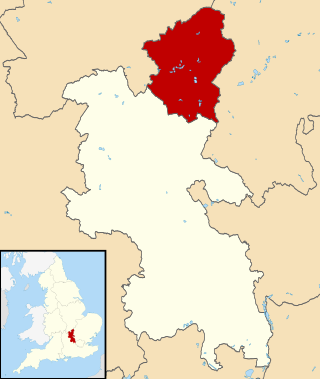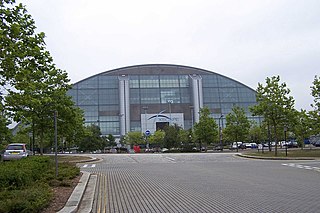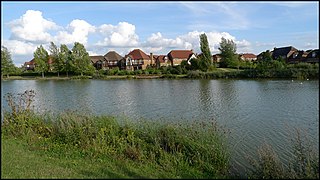Related Research Articles

Milton Keynes is a city in Buckinghamshire, England, about 50 miles (80 km) north-west of London. At the 2021 Census, the population of its urban area was 264,349. The River Great Ouse forms the northern boundary of the urban area; a tributary, the River Ouzel, meanders through its linear parks and balancing lakes. Approximately 25% of the urban area is parkland or woodland and includes two Sites of Special Scientific Interest (SSSIs).

The City of Milton Keynes is a unitary authority area with both borough and city status, in Buckinghamshire. It is the northernmost district of the South East England Region. The borough abuts Bedfordshire, Northamptonshire and the remainder of Buckinghamshire.

Bletchley is a constituent town of Milton Keynes, Buckinghamshire, England. It is situated in the south-west of the city, and is split between the civil parishes of Bletchley and Fenny Stratford and West Bletchley. In 2011, the two parishes had a combined population of 37,114.

Broughton is a historic village, modern district and civil parish in Milton Keynes, Buckinghamshire, England, approximately 3 miles (4.8 km) east of Central Milton Keynes. It is governed by Broughton and Milton Keynes Joint Parish Council, shared with the neighbouring Milton Keynes parish. Broughton district was developed during the 2000s and 2010s largely to the south and east of the historic village.
Shenley Brook End is a village, district and wider civil parish in Milton Keynes, Buckinghamshire, England, located about 2 miles (3.2 km) north-west of Bletchley, and 2.5 miles (4.0 km) south-west of Central Milton Keynes. Together with its neighbouring districts of Shenley Church End, Shenley Wood and Shenley Lodge, the districts are collectively known as "The Shenleys".

Walton was historically a hamlet and now a district and civil parish in Milton Keynes, Buckinghamshire, England. For local government purposes, it is part of the Danesborough and Walton electoral ward. At the 2021 census, the parish had a population of 12,100.

Hazard symbols are recognizable symbols designed to warn about hazardous or dangerous materials, locations, or objects, including electromagnetic fields, electric currents; harsh, toxic or unstable chemicals ; and radioactivity. The use of hazard symbols is often regulated by law and directed by standards organizations. Hazard symbols may appear with different colors, backgrounds, borders, and supplemental information in order to specify the type of hazard and the level of threat. Warning symbols are used in many places in place of or in addition to written warnings as they are quickly recognized and more universally understood, as the same symbol can be recognized as having the same meaning to speakers of different languages.

A balancing lake is a term used in the U.K. describing a retention basin used to control flooding by temporarily storing flood waters. The term balancing pond is also used, though typically for smaller storage facilities for streams and brooks.

Childproofing is the act of making an environment or object safe for children. This reduces risks to a level considered acceptable by a society, an institution, or to specific parents. Childproofing may include restriction of children to safe areas or preventing children from reaching unsafe areas. This can be accomplished by the parent or by hiring a professional for assistance. Childproofing is gaining more prominence now that parents have greater access to information on child injury and a wide variety of products are available to help prevent it. It has become so top-of-mind for parents that even hotels and child-friendly resorts are offering "child-proof" rooms.

Central Milton Keynes is the central business district of Milton Keynes, Buckinghamshire, England and a civil parish in its own right, with a town council.
Bletchley and Fenny Stratford is a civil parish with a town council, in Milton Keynes, Buckinghamshire, England. It was formed in 2001 from the unparished area of Milton Keynes, and according to the 2011 census had a population of 15,313. Together with West Bletchley, it forms the Bletchley built-up area.
Kents Hill, Monkston and Brinklow is a civil parish that covers the Kents Hill, Brinklow, Monkston, Monkston Park and Kingston districts of Milton Keynes in Buckinghamshire, England. As the first tier of Local Government, the Parish Council is responsible for the people, living and working in this area of Milton Keynes.

The Blue Lagoon Local Nature Reserve is a Local Nature Reserve in Bletchley, Milton Keynes in Buckinghamshire, United Kingdom. The Blue Lagoon is the only Local Nature Reserve in the City of Milton Keynes. The diverse habitat, including shallow and deep water, grassland, scrubland and woodland, hosts an abundance of fauna and flora. The Blue Lagoon is also extensively used as a recreational facility.

This history of Milton Keynes details its development from the earliest human settlements, through the plans for a 'new city' for 250,000 people in northern Southeast England, its subsequent urban design and development, to the present day. Milton Keynes, founded in 1967, is the largest settlement and only city in Buckinghamshire. At the 2021 census, the population of its urban area was estimated to have exceeded 256,000.

MK Metro was a bus company operating in Milton Keynes from 1997 until 2010.

Furzton is a district in south-west Milton Keynes, Buckinghamshire, England and in the civil parish of Shenley Brook End The man-made Furzton Lake is a balancing lake that covers approximately half of the district. The district lies just north of Bletchley, and roughly 2 miles (3.2 km) south of Central Milton Keynes.

A water ball or water walking ball is a large inflatable sphere that allows a person inside it to walk across the surface of a body of water. The giant ball is usually two metres in diameter and has a zippered entrance to allow for easy entry and exit. The water ball is similar to the zorb but it has only one layer and is designed for water travel rather than down-hill rolling. In the United Kingdom, the balls have been used at swimming pools, marinas and lakes in an effort to keep children fit.

The Sutton Life Centre is a community centre in Sutton, South London. It is an £8 million facility that uses audiovisual equipment to make young people more "street smart" and better able to deal with the dangers and risks they face in life. It was opened on 27 October 2010 by the then Deputy Prime Minister Nick Clegg.

Loughton and Great Holm is a civil parish in the City of Milton Keynes, Buckinghamshire, England. It includes the districts of Loughton, Great Holm, the National Bowl and Elfield Park, West Rooksley, Loughton Lodge, and Knowlhill. It is bordered by H4 Dansteed Way to the north, V4 Watling Street to the west, a tiny stretch of H8 Standing Way to the south, and the West Coast Main Line to the east. Originally named Loughton, it was renamed to Loughton and Great Holm in 2013
Electrical demonstrations during the eighteenth century were performances by experimental philosophers before an audience to entertain with and teach about electricity. Such displays took place in British America as well across Europe. Their form varied from something similar to modern day carnival shows to grand displays in exhibition halls and theatres. With concern about safety of electrical power, these displays were sometimes pushed back upon.
References
- ↑ "Home". safetycentre.co.uk.
- ↑ http://www.facebook.com/home.php#/group.php?gid=2475780664&ref=ts [ user-generated source ]